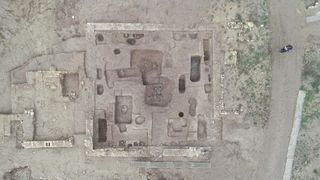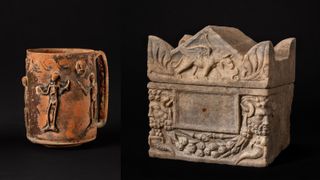1,430 ancient Roman graves scattered with funerary festival leftovers unearthed in southern France
Archaeologists in southern France have excavated an ancient Roman cemetery containing 1,430 graves and traces of a funerary festival, during which families feasted by the graves of relatives.

Archaeologists have unearthed a sprawling ancient Roman cemetery in southern France containing 1,430 graves and evidence of funerary banquets held in honor of deceased family members.
Excavations of the cemetery, called the Robine necropolis due to its proximity to a canal of the same name, began in 2017 ahead of construction work in the city of Narbonne. The funerary complex was "remarkably well-preserved," having been buried beneath a 10-foot (3 meters) blanket of silt during flooding of the nearby Aude River, according to a translated statement.
The graves and artifacts date to between the end of the first century B.C. and the end of the third century A.D. and include more than 100 tombs containing children's remains. Subsequent analyses showed the method of burial differed depending on the age of the deceased person: Children were buried, while the majority of adults were cremated. Adults who were buried without cremation were placed in wooden coffins, whereas children were placed in more rudimentary boxes or pits closed with a cover, according to the statement.
Some graves were scattered with chunks of charred food — including dates, figs, cereals and bread. Archaeologists think these were left over from feasts held by families in remembrance of deceased relatives. The feasts may have been part of a nine-day-long Roman festival known as "Parentalia," which families celebrated every year in February. The festival ended with an event called "Feralia" on Feb. 21, when families gathered in cemeteries with food, wine and other offerings for the dead.
Related: 'Exceptional' 1,800-year-old sarcophagus unearthed in France held woman of 'special status'
Excavations at the Robine necropolis uncovered several stone structures that may have served as banquet beds for families celebrating Feralia, according to the statement. The remains of libation tubes — hollow ceramic tubes inserted in the ground above graves — suggests families symbolically shared Feralia feasts with the dead by pouring food into their relatives' graves.
"The idea behind sharing a meal with your family dead was to connect with one’s ancestors," Maureen Carroll, a professor and chair in Roman archaeology at the University of York in the U.K. who was not involved in the recent excavations, told Live Science in an email. "By sharing a meal, and leaving behind a floral garland of flowers, the family ensured their ancestral dead continued to watch over them and aid their endeavours."
Sign up for the Live Science daily newsletter now
Get the world’s most fascinating discoveries delivered straight to your inbox.

The fully excavated necropolis spans 54,000 square feet (5,000 square m) and sits 2,300 feet (700 m) to the east of Narbonne's ancient Roman center. Narbonne, which was known in antiquity as Narbo Martius, was one of the first Roman colonies outside of Italy. The city was founded in 118 B.C. along the Via Domitia, a road stretching from Italy and across southern France to Spain.

The necropolis has two main areas arranged into a regular patchwork of burial plots and service roads, according to the statement. The first area borders a north-south road that crosses the Via Domitia and the second forms a strip further north, alongside a road linking Narbonne to the Mediterranean coast.
The archaeologists found that the cemetery evolved over time, highlighting changes in the layout of plots, tombs and boundaries. They discovered high stone walls erected around A.D. 50 that separated burials from one another, as well as extensions of the cemetery and further enclosures built toward the end of the first century A.D. The walls were decorated with marble funerary plaques that revealed the people buried in the necropolis were mostly Italian freedmen, according to the statement.
Many of the burials contained grave goods, including vases, balsams, lamps, coins and jewelry. These artifacts — along with a special set of amulets, miniature tools, bells and phallic pendants, which were viewed as apotropaic, or able to ward off evil — will be exhibited at the Narbo Via museum in Narbonne starting in 2026, according to the statement.

Sascha is a U.K.-based trainee staff writer at Live Science. She holds a bachelor’s degree in biology from the University of Southampton in England and a master’s degree in science communication from Imperial College London. Her work has appeared in The Guardian and the health website Zoe. Besides writing, she enjoys playing tennis, bread-making and browsing second-hand shops for hidden gems.
